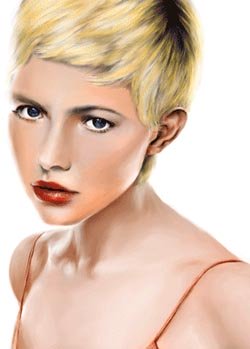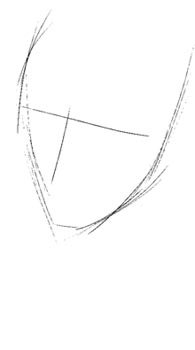Chapter 5:
Final Thoughts
All of the discussion in the previous chapters show that, unlike some other pastellists, I do indeed have a pretty good idea of what colors I will use in a pastel portrait long before I even begin to execute a painting and long before I even know I am going to paint one and long before I even see who it is I am going to paint.
An Important Tip: Whatever method you use in painting, establish your routine for it before you get started. Are you going to paint from big shapes to small shapes? Are you going to paint from darks to middle tones to lights? Are you going to "key" your painting? Are you going to ... whatever? Whichever method you use, decide these things ahead of time. By the way, "keying your painting" simply means determining and painting the lightest and the darkest areas first, and also doing so within each section of your painting. That way, you know that everything else you paint in that painting from then on, must be within those pre-established parameters, otherwise, your completed painting will look like a hodgepodge mess and you won't know why. The reason why is very simple. For example, if a pastel color you selected for a light shadow area was applied to a “look alike shade” dark middle tone area, confusion would arise, for even though they may look alike, you must bear in mind that, any light shadow tone is always darker than any dark middle tone. Thumbnail value sketches will indeed assist you in your thought analysis in avoiding this sort of error.
An Important Tip: Set your boundaries before you begin your drawing/painting process. That is, make a little mark, on your pastel paper, to indicate the placement for the top of the head or hair or hat, and determine where you are going to cut off the person at the bottom of the painting. Will it be just below the shoulders? Will it be near the waistline? Will it be a full-figure? Also, will it be a profile, a three-quarter, or a full-face portrait?
An Important Tip: It is much, much, much easier to copy a drawing or a painting when you are starting out in learning how to paint, than it is to paint from a photograph. Likewise, it is very, very, very difficult to paint a portrait of someone posing for you as a model --- unless, that is, that person is you. In which case, it is advantageous to have a large mirror handy. So, in the beginning, just look through your magazines, art or otherwise, visit museums, gravitate to the novels section of Christian bookstores to gaze at the pretty book covers, head for libraries in order to checkout art books with paintings of people or go online and seek books that showcase portrait paintings you admire.
For example, whereas I prefer “realism,” you may prefer “impressionist” portraits. Either way, very good sources for portraits are Christian journals and other like publications, for they are almost always full of beautiful custom paintings featuring male and female, young and old, biblical characters. I have many great works of art from these books and journals. I just use the pictures and ignore the rest for I have
The TRUTH
and you now have access to it. When I was a teenager, I copied practically all of the paintings found in my Bible.
Look for Christian portraits elsewhere, too, like on greeting cards for the holidays, especially Christmas. A few years ago, I obtained a book of great paintings from the “golden age” of commercial art in America, from the 1930’s to the 1960’s. You see some of these same paintings resurrected every Yuletide holiday season. Specifically seen every year, are the beautiful series of paintings of Santa Claus enjoying Coca Cola. This Christmas series was so powerful back in the 1930’s that this has become the defacto Santa of today, in that this is the Santa everyone envisions when they think about what Santa Claus looks like.
When I see these things, I tend to buy them. They are excellent material for building your skill level by trying to copy what these great artists did so well. I even have in my collection, a series of patriotic American art and posters, featuring art spanning the 20th Century, from the beginning of the century through World War I (Uncle Sam pointing and saying “I Want You”) and World War II and on through to the 1950’s. This was the age that produced such renowned illustrators such as Norman Rockwell (Saturday Evening Post covers), Andrew Loomis (Gerber Baby), Howard Chandler Christy (Christy Girl) and others. By the way, all three (3) illustrators were born within a couple of years of each other, and two (2) of them lived near each other. It was seeing Howard Chandler Christy's work in person that caused Andrew Loomis to become an artist. Even so, Norman Rockwell is my favorite artist of all time. Go to your local library and see if you can discover how these gentlemen painted so well. And while you are at it, look what modern day illustrators are doing with computer art, and even look at computer generated movie posters as well as art for computer games. Speaking of movie posters, I recently obtained a book of vintage posters, a calendar of vintage posters and a book of vintage posters featuring actresses as models, also from the same “golden age” of commercial art in America, which I discovered by accident. What a find!
Gather your own such art reference materials, for when you begin your practice sessions, you will already have a set of pre-painted portraits as your models.
NOTE: Make sure you practice by copying portrait paintings YOU admire, for this is the style you favor and will have enthusiasm in emulating over and over again, until you eventually develop your own unique style.
Believe it or not, in no time at all (maybe after three practice paintings), portrait painting will begin to become second nature to you.
Are you ready to paint, now? Then, get out your supplies and proceed.
You can wake up now from reading my boring eBook, for we are finally moving on as to why you are really reading my eBook turned website -- and that is for the tutorials.
However, before we get to the tutorials - You realize that you have read all the way to the end of my eBook, so, obviously you like it. Since that is true, then please make a
donation
to show your appreciation. Thank you.
Now that you have done that, let's move on to the tutorials. In the tutorials I discuss smudging, which some pastellists do not favor for some unexplained reason. Pastellists either like smudge blending or they do not. I have only found one instance where an artist stated why the technique is frowned upon. She said that in her case the process seems to destroy the crystal sparkling look of the finished painting. That is her reason, but she does not say if it also applies to other artists views.
Whereas I discuss smudge blending in the tutorials, I do not write about the pros and cons of spray fixing the finished, or near finished, pastel painting. The major complaint against fixing is that it darkens the whole painting or parts of it.
Now, it seems that a fixative manufacturer has supposedly solved all the negatives associated with the fixing process. You can read a review of this product from a blog of May 22, 2009 which is posted at this
link
. I hope you find that blog post enlightening.
You have heard the expression from a wiseman, "Give me a fish and I can eat for a day; Teach me to fish and I can eat for a liftime"? Well, using the same type of logic I want these pastel portrait tutorials to get you involved, for as another wise man said, "Tell me and I forget; Show me and I remember; Involve me and I learn." The purpose here is for you to learn how to paint pastel portraits on your own.
So, let's take a look at our initial fascinating series of step-by-step lessons...



First Tutorial: How To Draw and Paint Drawgirl
Enjoy this page? Please pay it forward. Here's how...
Would you prefer to share this page with others by linking to it?
- Click on the HTML link code below.
- Copy and paste it, adding a note of your own, into your blog, a Web page, forums, a blog comment,
your Facebook account, or anywhere that someone would find this page valuable.